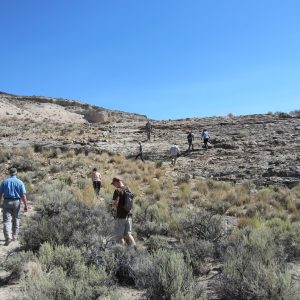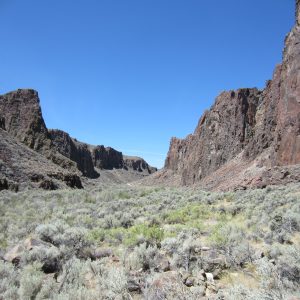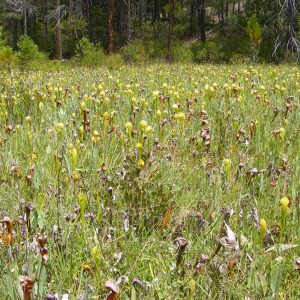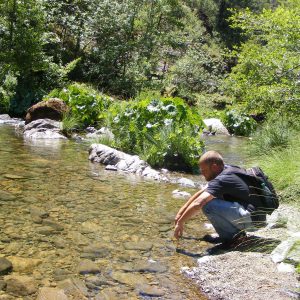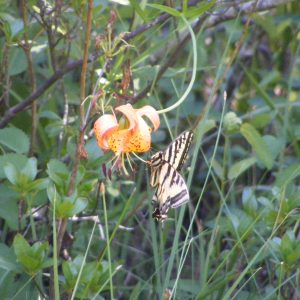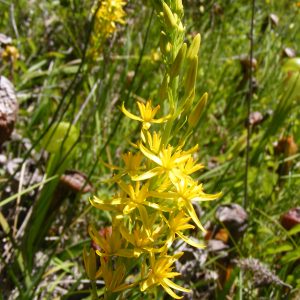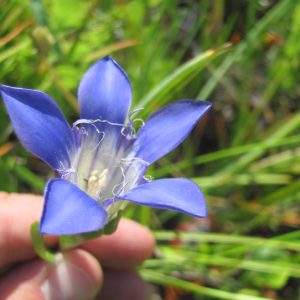The month of August has proven to be a slow one. With evasive monsoons, we haven’t had enough water to sustain life. But, we have done our best to chase down rain in search for signs of life and seeds! In the meantime, my partner and I have had the opportunity to assist on different projects: rangeland health assessments; help well-known botanist collect plant samples for his herbarium (and some for the BLM office of course); explore the wetlands and dry lands of the Carson National Forest with former Forest Service employees.
The sporadic rains of August were enough to aid in seed production and the end of August/beginning of September looked more promising in terms of collecting. We have made a couple of good collections with even more on the horizon. Of course the last few weeks weren’t all about work. We made time to play!
Last month I turned one year older and one year wiser. Even though my friends and family are on lands far away, the people here helped make the day very special. I gifted myself a road trip to Oregon to visit a group of friends. We spent Labor Day weekend in the Three Sisters Wilderness surrounded my wild blueberries and huckleberries and a panoramic view of the mountains and a serene Alpine lake. The hike in was tough (funniest and worse part was being ambushed by ground nesting bees because I accidentally stepped near their nest…whoops) but as usual the journey was worth the reward. Last Friday was United Way sponsored Day of Caring. A few of us from the office spent the morning painting the ceiling of a children’s learning center. It was such a wonderful day to service the community! Then again, what day isn’t? Last but not least I finally got to experience a real thunderstorm. It has been consistently raining for hours; it started yesterday afternoon and has continued through to this morning. Hopefully the water will bring new life and didn’t wash away the seeds!
Monthly Archives: September 2013
Pasture picture
I had the opportunity to assist in a few rangeland health assessments with our range peoples in the office lately. This was a great new experience and another weapon in the arsenal of experience this internship has given me. These rangeland health assessments are done as part of the permit renewal on pasture allotments every ten years. The assessment consists of evaluating seventeen attributes of an area such as hydrology, erosion, and biotic integrity. The process starts by running a point step transect with one hundred points and marking what was hit on a form. Next hooping and clipping is done to measure productivity and then the seventeen attributes can be assessed. The process is a mixture of quantitative and qualitative data used to give an idea of the pastures quality at that point in time. The assessment is not used to measure what management practices should be taken on the land, it is simply a picture in time of the condition of the pasture. The assessments are done multiple times throughout the pasture allotment the areas are selected randomly in order to get a representative idea of the pasture allotment. Until next time people of the internet!
Public outreach and weed management
Here is another month of action in Arcata, CA. This month brought some new topics and activities, mostly relating to public outreach. The Humboldt county fair happened through the middle of August and as the BLM is a chief member of the Humboldt county Weed Management Area (HWMA), we set up and manned the HWMA’s booth at the fair. The booth featured lots of information on many of the common and most invasive weeds in Humboldt County. It also included vases full of examples of these plants, so the public could see them up close and personally. My mentor and I set up and maintained the booth, which involved keeping our selection of cut invasive plants looking fresh and beautiful (ironically enough). I also had the pleasure of manning the booth, which turned out to be quite fun. Many visitors were interested in the booth and asked loads of questions regarding various weeds they have in their yards. Some of the weeds we had put on display people did not realize were invasive, so it was good to educate them on the various negative effects these plants have on the landscape.
We also led a public hike to Red Mountain, which is part of the South Fork Eel Wilderness, which is home to numerous rare, endangered and endemic plants due to its serpentine soils. There were a variety of people on the hike with a range of botanical knowledge. Some of them just wanted to go for a hike in a beautiful place, while others wanted to know the name of every plant they saw. And as usual, when you go on a walk with a bunch of plant folks, things move very slowly. Given Red Mountain’s geographical situation and that it is surrounded by private land, it is not accessible to the public and we need the neighbor’s permission to enter. There is only one neighbor that will actually allow us to cross their land to Red Mountain.
I have also been swamped with seeds this month. Everything is ripening right now, so I’ve been collecting rather frantically. I think I made seven collections of 10,000+ seeds each this month bringing my total number of collections for the year up to twelve. Since I am a one-man collecting team, and some of the species can be quite tedious to collect, I have spent many days collecting seeds recently. I did get some help from one of our law enforcement officers, who came out with me as part of his homework to work with the resource staff and learn about the resources and land he is protecting. It was certainly an educational experience for both of us, as spending the day with a cop is something I’ve never done. He has to be in a completely different mindset than the rest of us “normal-folk” – always looking for the “bad-guys”.

I collected seeds from the Oregon gumweed (Grindelia stricta) along Seven Mile Beach. Not a bad spot to make a collection.
There has also been lots of fires up here in Northern California, so much of our office’s resource staff has been called into these fires as resource advisors. This has also caused lots of smoke to blow in and out of the areas where we work. Fire certainly is a hot topic around these parts right now…
The time is flying by here in Arcata, I took a vacation at the end of the month to do some backpacking in the mountains NE an SE of here, which were epic trips. I ‘m happy to have ended up in such a great location that has so much to offer.

Views from Strawberry Rock, where I’ve made several seed collections, looking down on the mouth of the Mattole River
Monsoon Abundance
It’s still raining. Monsoon clouds still build from the southeast. But the first winds of autumn can already be felt in the air. Even though it feels as though it just began, the summer is on its way out.
It was only two months ago that the soil was desiccated and powdered. Vegetation was a crispy and golden. The sun shone all day, drying the land and parching the lips.
A little over a week ago I woke up early to work with the community to help salvage some native Giant Sacaton grass. Our pants were soaked with morning dew as we moved through the grass. Views of cloudscapes clutching mountain peaks dramatically surrounded us as we trimmed a summer’s worth of growth off of the clumps of grass. As we dug up the bunch grass, children scanned the vegetation for caterpillars. Each caught caterpillar earned 5 cents to the captor. And these creatures were mowing down the swelling vegetation at a tremendous pace.
I have witnessed water beget vegetation and vegetation beget caterpillars and grasshoppers (which are now so abundant that I have to dodge them as I drive to work.) Migrating birds have just entered Patagonia to devour the cornucopia of insects. And it all begins with water.
While summer begins to dwindle, migration begins to take off. I am fortunate to be able to witness this changing of the seasons through annual ecological succession. What a fun job to be able to witness this shifting.
Harvest Time
Greetings from Wyoming!
It finally happened—not Fall per se, but that first day when you realize the summer will have to come to an end. From a botanical perspective, focus has swiveled around to scoping out sages and shrubs. It took me a while, but I am starting to appreciate the late season action, so different from the early excitement of blooms. The fruiting time can be beautiful, too.
There can be some unexpected encounters in the field. A few weeks ago, we were out chasing plants along a little-used road and ran smack into the historical Fort Laramie. It was a good lunch spot and a beautiful day, and we took a little time to wander around the buildings and exhibits. That was also the day we ran across some wild plums!
My team has gone back to school, so it looks like much of my fieldwork will be solo from now on. I really appreciated them, their company and extra pairs of seed collecting hands!
Cheers,
Abby D.
An Early Fall
Leaf loss in the California floristic province is often dictated more by drought than temperature. This has been noticeable the past few months in the Sierra foothills, especially since the past two years have been exceptionally dry. The buckeyes were the first to shed their wide, almost tropical looking leaves. They prefer to wait out the Mediterranean summer without a fight, while other species keep their small waxy leaves in protest to the heat and drought. Next the abundant poison oak began to turn shades of yellow and red, and is now on its way to being completely leafless, with only its inconspicuous stems promising a rash. The California redbuds also turned various shades of autumn color as early as August. Twice a year redbuds exhibit a showiness that other chaparral shrubs shun in favor of toughness and practicability. In early spring the hills are alighted with thousands of bright pink blossoms on leafless stems, and in fall the leaves turn deep colors reminiscent of Eastern forests. Today I was able to collect redbud seed pods for the Seeds of Success program.
This pay period would have been the last for my internship, but I have been extended into early November. I now have a much more intimate understanding of the Pine Hill Preserve since I started working here five months ago. I have started calling the plants by their USDA plants code, which have been drilled into my head through repeated monitoring activities. For example, Salvia sonomensis, a ubiquitous sage that creeps underneath chaparral shrubs on long stolons, is known fondly as “SASO”. All eight of the Pine Hill Preserve rare plant species pop out at me, even late in the season when many of them have lost their above ground portions to the relentless heat. I have even been able to predict their presence a few times, when the gabbro soil turns a particularly otherworldly shade of red-brown and the chaparral becomes stunted due to the concoction of growth inhibiting chemicals in which the rare plants have undergone speciation. While seed collecting and monitoring I have army crawled through the silent, dusky under story of manzanita, and crashed through nearly impenetrable stands of unforgiving chamise. I often find that my pockets are full of chamise leaves at the end of the day. I can see why the Native Americans burned this ecosystem, if for nothing else just to be able to walk through it!
Last week I was given a respite from this difficult to navigate ecosystem. A cadre of field work hungry biologists and I were able to assist some guys from a lab at Utah State University who are working on a project to collect data on watersheds throughout BLM lands. It was extremely refreshing to be able to help collect data while half immersed in the clear, cold water of the North fork of the American river. We also ran into some interesting folks who were camping and gold mining along the river, proving there are remnants of the old West in California, once you get off the main highways.
As the heat and drought persist, I find myself waiting, perhaps less patiently than the chaparral, for the earth to tilt away from the sun and for the Alaskan low pressure system to reassert its dominance over the Hawaiian high. Hopefully this will bring a cool, wet winter, and the Pine Hill Preserve plants can uncurl their crispy foliage, green up, and produce sprigs of fresh growth.
Joe Broberg
BLM Mother Lode field office
Goodbye Nevada
Writing my final wrap-up blog came sooner than I expected. The last five months have flown by. I had many great experiences that brighten my resume considerably. I came to this internship with no on-the-job experience with GPS, GIS, seed collecting, habitat assessment framework-HAF, assessment inventory and monitoring-AIM strategy, and much more. Being a BLM employee, I received trainings in hazardous materials, first aid, CPR, and ATV operation. I also participated in big trainings sessions; the Conservation of Land Management workshop, a pollinator course, Interpreting Indicators of Rangeland Health, and a Vegetation Rapid Assessment Relevé. I also participated in taking surveys and researching endangered butterflies and multiple plant species. Outreach events allowed us to work with younger children and teach them about plants, animals, biodiversity and the importance of it all. While these events were keeping me busy, I discovered some of the things that make Nevada special. The scenery at first to me was a plain and boring desert landscape. After spending some time outside I saw beautiful mountains that seemed to never end with breathtaking sunsets and sunrises for backdrops. I was treated to multiple bear sightings while out in the field. The wild horses were very exciting to see for the first time. Overall, the knowledge and experiences gained during my CLM internship are irreplaceable and I would do it again if given the chance.
Back in the office, Ready for Autumn
Field season ended in early August, so since then I’ve been firmly ensconced in the Wetlands field office. It’s been a relatively calm month, mostly revolving around the paperwork that results in the aftermath of field season, and office organization. Data entry is always prominent in the wake of monitoring, and after carefully administering heaps of information into tables, I find myself surprised at the stack of paperwork we managed to generate over the past five months.
In addition to data entry, office organization has become a focus of mine. With the hustle and bustle of people going to and returning from the field, some tasks get pushed to the wayside in the face of higher priority projects. I am now filing hardcopy data in our archives and taking on the tasks of organizing over six years worth of photographs into an easily navigable system of folders; I truly never realized just how many photographs of the wetlands existed until I began sifting through hundreds upon hundreds of pictures.
Later in September and October, I may have the opportunity to assist with seeding native species, and possibly even helping out with National Public Lands Day, but for now I am enjoying the chance to get the office in order.
Hot in the surprise valley!
Hello all,
With the seed collection of two more species and continuing with ESR monitoring on the Lost Creek fire, this past month has been definitely one of the fastest of my time in northeastern California. The seed collection season on the resource area is almost over, we are now only waiting for sagebrush species to seed out to be able to make some good collections of the various species present in the area. In the meantime we have been working on ESR monitoring, which is one of the most time consuming tasks that I have worked on. After GIS selects random points on the different pastures on the burned area, we drive and hike to the site and verify the site to match with the Ecological Site Descriptions so that we can compare it to the paired unburned site. After positively verifying the sites, we began the data collection through transects and different methods mentioned in the protocol. And of course all that data collected needs to be entered in database somehow, so some hours are spent in the office doing that.
Besides from ESR monitoring and seed collecting. I have also worked on surveys on pre and post fire fuel reduction projects (juniper tree stands cuts).
Another interesting activity was a day of riparian areas assessment with a complete team of the range specialist, the wildlife biologist and ecologist where they assessed a few springs on pastures that were up for grazing contract renewal. It was interesting to see the different points of view collaborating to come to a decision for management actions.
I also got the opportunity to join a field office tour of the high rock canyon trail. It was a fun learning trip where we got to see that very remote place with such an amazing geology, soil and elevation diversity.
So far it has been a fun learning experience here at the Surprise Valley looking forward to more learning opportunities.
Until next time,
Hector
2013 Conservation and Land Management Intern
BLM Surprise Field Office
A Time for Reflection
Here we are, the end of the journey that has opened my mind to just how incredible Southern Oregon truly is. I consider myself to be amazingly fortunate that I have this diversified ecosystem as my backyard and all that it contains. I have appreciated so much working with my mentor Doug Kendig and my partner in crime, Marcus Lorusso, over these past months. The skill set that I tackled will help to serve me in my future endeavors for sure. I will never stop thirsting for knowledge to grow and expand my understanding of the world around me, and I have many outdoor excursions planned for myself even after this experience comes to a close.
Darlingtonia californica and the Calochortus howelii have been my two favorite species encountered this summer. One for its awesome carnivorous and sometimes mysterious ways, and the other for its shear beauty and rarity. Marcus has taught me more than I could have imagined over my time here, and I cannot be more thankful. An absolute incredible experience that I will no doubt ever forget. Those I was able to meet in Chicago, I wish you all the best in life and finding your own path. It was astounding to be surrounded by so many brilliant minds; I count myself extremely fortunate. Thanks to Krissa and Wes,
and their team for all their hard work to make all of this possible! Live, love, and enjoy life. Hopefully I’ll have the opportunity to see some of you again soon.
Jonathan Matthews





















